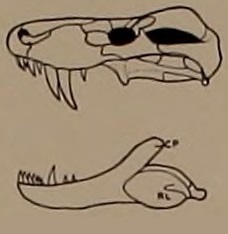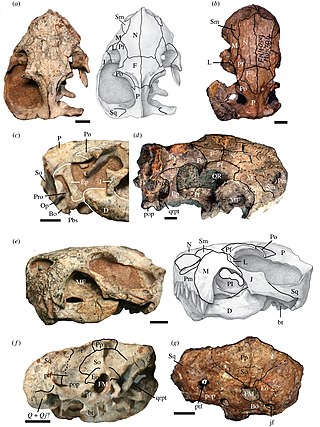
Therapsida is a clade composing of a major group of eupelycosaurian synapsids that includes mammals and their ancestors and close relatives. Many of the traits today seen as unique to mammals had their origin within early therapsids, including limbs that were oriented more underneath the body, as opposed to the sprawling posture of many reptiles and salamanders.

Therocephalia is an extinct clade of eutheriodont therapsids from the Permian and Triassic periods. The therocephalians ("beast-heads") are named after their large skulls, which, along with the structure of their teeth, suggest that they were carnivores. Like other non-mammalian synapsids, therocephalians were once described as "mammal-like reptiles". Therocephalia is the group most closely related to the cynodonts, which gave rise to the mammals, and this relationship takes evidence in a variety of skeletal features. Indeed, it had been proposed that cynodonts may have evolved from therocephalians and so that therocephalians as recognised are paraphyletic in relation to cynodonts.

Anteosaurus is an extinct genus of large carnivorous dinocephalian synapsid. It lived at the end of the Guadalupian during the Capitanian stage, about 265 to 260 million years ago in what is now South Africa. It is mainly known by cranial remains and few postcranial bones. Measuring 5–6 m (16–20 ft) long and weighing about 600 kg (1,300 lb), Anteosaurus was the largest known carnivorous non-mammalian synapsid and the largest terrestrial predator of the Permian period. Occupying the top of the food chain in the Middle Permian, its skull, jaws and teeth show adaptations to capture large prey like the giants titanosuchids and tapinocephalids dinocephalians and large pareiasaurs.

Trochosaurus is a dubious genus of therocephalian therapsid from South Africa based upon specimens of Lycosuchidae. Three species of Trochosaurus have appeared in literature, T. intermedius, T. major, and T. dirus. The genus Trochosaurus and all three species are considered nomen dubia today, while the specimens referred to them are regarded as Lycosuchidae incertae sedis.

Euchambersia is an extinct genus of therocephalian therapsids that lived during the Late Permian in what is now South Africa and China. The genus contains two species. The type species E. mirabilis was named by paleontologist Robert Broom in 1931 from a skull missing the lower jaw. A second skull, belonging to a probably immature individual, was later described. In 2022, a second species, E. liuyudongi, was named by Jun Liu and Fernando Abdala from a well-preserved skull. It is a member of the family Akidnognathidae, which historically has also been referred by as the synonymous Euchambersiidae.

Moschorhinus is an extinct genus of therocephalian synapsid in the family Akidnognathidae with only one species: M. kitchingi, which has been found in the Late Permian to Early Triassic of the South African Karoo Supergroup. It was a large carnivorous therapsid, reaching 1.5 m (4.9 ft) in total body length with the largest skull comparable to that of a lion in size, and had a broad, blunt snout which bore long, straight canines.

Theriognathus is an extinct genus of therocephalian therapsid belonging to the family Whaitsiidae, known from fossils from South Africa, Zambia, and Tanzania. Theriognathus has been dated as existing during the Late Permian. Although Theriognathus means mammal jaw, the lower jaw is actually made up of several bones as seen in modern reptiles, in contrast to mammals. Theriognathus displayed many different reptilian and mammalian characteristics. For example, Theriognathus had canine teeth like mammals, and a secondary palate, multiple bones in the mandible, and a typical reptilian jaw joint, all characteristics of reptiles. It is speculated that Theriognathus was either carnivorous or omnivorous based on its teeth, and was suited to hunting small prey in undergrowth. This synapsid adopted a sleek profile of a mammalian predator, with a narrow snout and around 1 meter long. Theriognathus is represented by 56 specimens in the fossil record.

Bullacephalus is an extinct genus of biarmosuchian therapsids belonging to the family Burnetiidae. The type species B. jacksoni was named in 2003. It is known from a relatively complete skull and lower jaw, discovered in the Late Permian Tapinocephalus Assemblage Zone of the Beaufort Group of South Africa. This genus of therapsida lived during the Late Permian period, approximately 250 million years ago. The name Bullacephalus comes from the Latin words "bullatus," meaning "bossed" or "knobbed," and "cephalus," meaning "head." This name refers to the distinctive bony knob on the top of the therapsid's skull, which contributes to the history of this genus. This stem based taxon includes Ictidorhinus or Hippasaurs. Bullacephalus can even be characterized as having a, “skull moderately to greatly pachyostotic; swollen boss present above the postorbital bar formed by the postfrontal and postorbital; deep linear sculpturing of the snout; exclusion of the jugal from the lateral temporal fenestra”. These Therapsids have spongy bone skull roof, palatal process of premaxilla are long, diverticulum of naris adding them to the Burnetiamorph. Furthermore, the discovery of Bullacephalus has helped to refine the taxonomic classification of therapsids. Prior to its discovery, there was uncertainty regarding the relationship between different groups of therapsids, particularly the Burnetiamorpha and the Biarmosuchia. However, the distinctive features of Bullacephalus suggest that it is a member of the Burnetiamorpha, and provides a bridge between this group and the Biarmosuchia. The discovery of Bullacephalus has also highlighted the importance of continued exploration and excavation in areas that have yielded few therapsid fossils. The Beaufort Group of South Africa, where Bullacephalus was discovered, has been an important site for therapsid fossils, but much of the area remains unexplored. Further discoveries in this region and other areas around the world may provide new insights into the evolution and diversification of therapsids, as well as other groups of extinct animals. These discoveries will also help to refine our understanding of the history of life on Earth and the processes that have shaped the diversity of organisms that exist today.

Scymnosaurus is a dubious genus of therocephalian therapsids based upon various fossils of large early therocephalians. The genus was described by Robert Broom in 1903 with S. ferox, followed by S. watsoni in 1915 and a third, S. major, by Lieuwe Dirk Boonstra in 1954. Each of these species are considered nomen dubia today and based upon specimens belonging to two separate families of therocephalians. S. ferox and S. major represent specimens of Lycosuchidae incertae sedis, while S. watsoni is Scylacosauridae incertae sedis. Broom named a fourth species in 1907 from KwaZulu-Natal, S. warreni, though he later referred it to Moschorhinus as a valid species in 1932 but now is recognised as being synonymous with M. kitchingi.
Trochosuchus is a dubious genus of therocephalian therapsid from the middle Permian (Capitanian) of South Africa based on a weathered and poorly preserved undiagnostic fossil of a lycosuchid therocephalian. It includes the type and only species, T. acutus. Trochosuchus was named by palaeontologist Robert Broom in 1908 based on its supposedly unique proportions of the simulatenous 'double' functional canines thought to be characteristic of lycosuchids, with the pair in front being noticeably smaller than the second pair behind.

Lycosuchidae is an extinct family of therocephalian therapsids from the Middle Permian Beaufort Group of South Africa. It currently contains two monotypic genera, Lycosuchus, represented by L. vanderrieti, which was named by paleontologist Robert Broom in 1903, and Simorhinella, represented by S. baini, which was named by Broom in 1915. Both species are characterized by their large body sizes and short, deep snouts. Two sets of enlarged canine teeth were once regarded as a defining feature of lycosuchids, but recent studies have proposed that the front-most pair are replacements for the ones behind them, which would have eventually fallen out as individuals aged. Lycosuchids are the earliest known therocephalians and are also thought to be the most basal.

Baurioidea is a superfamily of therocephalian therapsids. It includes advanced therocephalians such as Regisaurus and Bauria. The superfamily was named by South African paleontologist Robert Broom in 1911. Bauriamorpha, named by D. M. S. Watson and Alfred Romer in 1956, is a junior synonym of Baurioidea.

Choerosaurus is an extinct genus of therocephalian therapsids from the Late Permian of South Africa. The type species Choerosaurus dejageri was named by South African paleontologist Sidney H. Haughton from the Tropidostoma Assemblage Zone in 1929.

Blattoidealestes is an extinct genus of therocephalian therapsid from the Middle Permian of South Africa. The type species Blattoidealestes gracilis was named by South African paleontologist Lieuwe Dirk Boonstra from the Tapinocephalus Assemblage Zone in 1954. Dating back to the Middle Permian, Blattoidealestes is one of the oldest therocephalians. It is similar in appearance to the small therocephalian Perplexisaurus from Russia, and may be closely related.
Silpholestes is an extinct genus of therocephalian therapsids from the Late Permian of South Africa. The type species Silpholestes jackae was named by South African paleontologist Robert Broom in 1948 from the Cistecephalus Assemblage Zone.
Ictidodraco is an extinct genus of therocephalian therapsids from the Late Permian of South Africa. The type species Ictidodraco longiceps was named by South African paleontologists Robert Broom and John T. Robinson in 1948 from the Cistecephalus Assemblage Zone. Ictidodraco was once classified as a scaloposaurian in the family Silpholestidae. Scaloposauria and Silpholestidae are no longer regarded as valid groups, and Ictidodraco is now classified as a basal member of the clade Baurioidea.
Scalopodon is an extinct genus of therocephalian therapsids from the Late Permian of Russia. The type species Scalopodon tenuisfrons was named in 1999 from the Kotelnichsky District of Kirov Oblast. Scalopodon is known from a single fragmentary holotype specimen including the back of the skull, the left side of the lower jaw and isolated postorbital and prefrontal bones. The skull was found in the Deltavjatia Assemblage Zone, which dates back to the early Wuchiapingian about 260 million years ago. Distinguishing features of Scalopodon include narrow frontal bones and a distinctive sagittal crest along the parietal region at the back of the skull. Scalopodon was originally classified in the family Scaloposauridae, and was the first scaloposaurid found in Russia. More recent studies of therocephalians have found scaloposaurids like Scalopodon to be juvenile forms of larger therocephalians and do not consider Scaloposauridae to be a valid group. Scalopodon and most other scaloposaurids are now classified as basal members of Baurioidea.
Lycideops is an extinct genus of therocephalians from the Late Permian of South Africa. The type species is Lycideops longiceps, named in 1931 by South African paleontologist Robert Broom. Fossils of Lycideops come from the Dicynodon Assemblage Zone of the Beaufort Group. Lycideops is a member of the family Lycideopidae. Like other lycideopids, Lycideops has a long snout.

Urumchia is an extinct genus of therocephalian therapsids from the Early Triassic of China. The type species Urumchia lii was described by Chinese paleontologist C. C. Young in 1952 from the Jiucaiyuan Formation in Xinjiang. The holotype skull has been lost, but Young was able to describe the species on the basis of a detailed cast of the skull. Urumchia is similar to the South African therocephalian Regisaurus in having an expanded pair of vomer bones on the underside of the skull that form a secondary palate. In Urumchia the front end of the vomers narrow to a point, while in Regisaurus they do not. Urumchia has six incisors on either side of the upper jaw, a primitive condition among baurioid therocephalians that usually have fewer incisors.

Ictidosaurus was a therapsid genus found in the Abrahamskraal Formation of South Africa, which lived during the middle Permian period. Fossils of the type species were found in the Tapinocephalus, and the base of the Eodicynodon assembly zones, of the Karoo Basin. Older classifications of the species, along with many other specimens found in the Iziko South African Museum archives, were originally classified within therocephalian family names, in this case the Ictidosauridae, which has been reclassified as belonging to the Scylacosauridae. The type species is I. angusticeps.



















